All Exams >
JAMB >
Physics for JAMB >
All Questions
All questions of Scalars and Vectors for JAMB Exam
If  what is the angle between
what is the angle between  and
and 
- a)900
- b)300
- c)600
- d)450
Correct answer is option 'D'. Can you explain this answer?
If  what is the angle between
what is the angle between  and
and 
 what is the angle between
what is the angle between  and
and 
a)
900
b)
300
c)
600
d)
450
|
|
Gaurav Kumar answered |
We know that for two vectors P and Q
P.Q = |P||Q| cos a
And PxQ = |P||Q| sin a
Where a is angle between them
When P.Q = PxQ
We get sin a = cos a
Thus a = 450
P.Q = |P||Q| cos a
And PxQ = |P||Q| sin a
Where a is angle between them
When P.Q = PxQ
We get sin a = cos a
Thus a = 450
Which of the following is not a scalar quantity?- a)Temperature
- b)Coefficient of friction
- c)Charge
- d)Impulse
Correct answer is option 'D'. Can you explain this answer?
Which of the following is not a scalar quantity?
a)
Temperature
b)
Coefficient of friction
c)
Charge
d)
Impulse
|
|
Vivek Patel answered |
Impulse (I)
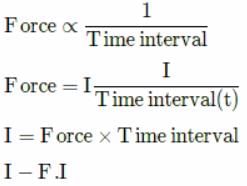
Since force is a vector quantity and impulse is the product of the sudden force applied and the time interval to bring equivalent the system. So Impulse also a vector quantity which have same direction to the force applied.

Since force is a vector quantity and impulse is the product of the sudden force applied and the time interval to bring equivalent the system. So Impulse also a vector quantity which have same direction to the force applied.
A bird is tossing (flying to and fro) between two cars moving towards each other on a straight road. One car has speed of 27 km h−1 while the other has the speed of 18 km h−1. The bird starts moving from first car towards the other and is moving with the speed of 36 km h−1 when the two were separated by 36 km. The total distance covered by the bird is- a)28.8 km
- b)38.8 km
- c)48.8 km
- d)58.8 km
Correct answer is option 'A'. Can you explain this answer?
A bird is tossing (flying to and fro) between two cars moving towards each other on a straight road. One car has speed of 27 km h−1 while the other has the speed of 18 km h−1. The bird starts moving from first car towards the other and is moving with the speed of 36 km h−1 when the two were separated by 36 km. The total distance covered by the bird is
a)
28.8 km
b)
38.8 km
c)
48.8 km
d)
58.8 km
|
|
Ajay Yadav answered |

Velocity of car A, vA = +27kmh−1
Velocity of car B, vB = −18kmh−1
Relative velocity of car A with respect to car B
=vA − vB = + 27kmh−1 (−18kmh−1) = 45kmh−1
Time taken by the two cars to meet = 36 km/45 km h-1 = 0.8
Time taken by the two cars to meet = 36 km/45 km h-1 = 0.8
Thus, distance covered by the bird
= 36kmh−1 x 0.8h = 28.8km
= 36kmh−1 x 0.8h = 28.8km
A bus is moving with a speed of 10ms−1 on a straight road. A scooterist wishes to overtake the bus in 100s. If the bus is at a distance of 1km from the scooterist with what speed should the scooterist chase the bus?- a)40 ms-1
- b)25 ms-1
- c)115 m s-1
- d)125 ms-1
Correct answer is option 'D'. Can you explain this answer?
A bus is moving with a speed of 10ms−1 on a straight road. A scooterist wishes to overtake the bus in 100s. If the bus is at a distance of 1km from the scooterist with what speed should the scooterist chase the bus?
a)
40 ms-1
b)
25 ms-1
c)
115 m s-1
d)
125 ms-1
|
|
Raghav Bansal answered |
Let vs be the velocity of the scooter, the distance between the scooter and the bus = 1000m,
The velocity of the bus = 10ms−1
Time taken to overtake = 100s
Relative velocity of the scooter with respect to the bus = (vs − 10)
1000/(vs − 10) = 100s
= vs = 20ms−1
A police van moving on a highway with a speed of 30km h−1 fires a bullet at a thief's car speeding away in the same direction with a speed of 192km h−1. If the muzzle speed of the bullet is 150ms−1 , with what relative speed does the bullet hit the thief's car?- a)95 ms-1
- b)105 m s-1
- c)115 ms-1
- d)125 m s-1
Correct answer is option 'B'. Can you explain this answer?
A police van moving on a highway with a speed of 30km h−1 fires a bullet at a thief's car speeding away in the same direction with a speed of 192km h−1. If the muzzle speed of the bullet is 150ms−1 , with what relative speed does the bullet hit the thief's car?
a)
95 ms-1
b)
105 m s-1
c)
115 ms-1
d)
125 m s-1
|
|
Mira Joshi answered |
Speed of police van w.r.t. ground
∴ vPG = 30kmh−1
Speed of thief’s car w.r.t. ground
∴ vTG = 192kmh−1
Speed of bullet w.r.t. police van

Speed with which the bullet will hit the thief’s car will be
vBT = vBG + vGT = vBP + vPG + vGT
= 540kmh−1 + 30kmh−1 − 192kmh−1
(∵ vGT = −vTG)


Two parallel rail tracks run north-south. On one track train A moves north with a speed of 54kmh−1 and on the other track train B moves south with a speed of 90kmh−1. The velocity of train A with respect to train B is- a)10 ms-1
- b)15 ms-1
- c)25 ms-1
- d)40 ms-1
Correct answer is option 'D'. Can you explain this answer?
Two parallel rail tracks run north-south. On one track train A moves north with a speed of 54kmh−1 and on the other track train B moves south with a speed of 90kmh−1. The velocity of train A with respect to train B is
a)
10 ms-1
b)
15 ms-1
c)
25 ms-1
d)
40 ms-1
|
|
Preeti Iyer answered |
Let the positive direction of motion be from south to north. Velocity of train A with respect to ground
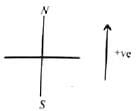


Velocity of train B with respect to ground

Relative velocity of train A with respect to train B is

The vector that must be added to the vector  so that the resultant vector is a unit vector along the y-axis is
so that the resultant vector is a unit vector along the y-axis is
- a)

- b)

- c)

- d)Null vector
Correct answer is option 'B'. Can you explain this answer?
The vector that must be added to the vector  so that the resultant vector is a unit vector along the y-axis is
so that the resultant vector is a unit vector along the y-axis is
 so that the resultant vector is a unit vector along the y-axis is
so that the resultant vector is a unit vector along the y-axis isa)

b)

c)

d)
Null vector

|
Ambition Institute answered |
Unit vector along y axis =  so the required vector =
so the required vector = 

 so the required vector =
so the required vector = 

Two cars A and B are running at velocities of 60 km h−1 and 45 km h−1. What is the relative velocity of car A with respect to car B, if both are moving eastward?- a)15 km h-1
- b)45 km h-1
- c)60 km h-1
- d)105 km h-1
Correct answer is option 'A'. Can you explain this answer?
Two cars A and B are running at velocities of 60 km h−1 and 45 km h−1. What is the relative velocity of car A with respect to car B, if both are moving eastward?
a)
15 km h-1
b)
45 km h-1
c)
60 km h-1
d)
105 km h-1
|
|
Anjali Sharma answered |
Velocity of car A w.r.t. ground
∴ vAG = 60 kmh−1
Velocity of car B w.r.t. ground
∴ vBG = 45 km h−1
Relative velocity of car A w.r.t. B
vAB = vAG + vGB
=vAG − vBG = 15 km h−1 (∵ vGB = −vBG)
The direction cosines of are
are - a)1, 1, 1
- b)2, 2, 2
- c)1/√2, 1/√2, 1/√2
- d)1/√3, 1/√3, 1/√3
Correct answer is option 'D'. Can you explain this answer?
The direction cosines of are
are
 are
are a)
1, 1, 1
b)
2, 2, 2
c)
1/√2, 1/√2, 1/√2
d)
1/√3, 1/√3, 1/√3

|
Shubham Mogre answered |
This is the question of unit vector solve through that concept.....
In Latin, the word vector means- a)Magnitude
- b)Direction
- c)Carrier
- d)Cap
Correct answer is option 'C'. Can you explain this answer?
In Latin, the word vector means
a)
Magnitude
b)
Direction
c)
Carrier
d)
Cap
|
|
Hansa Sharma answered |
In Latin, the word vector means carrier.
Two parallel rail tracks run north-south. On one track train A moves north with a speed of 54 kmh−1 and on the other track train B moves south with a speed of 90kmh−1. What is the velocity of a monkey running on the roof of the train A against its motion with a velocity of 18 kmh-1 with respect to the train A as observed by a man standing on the ground?- a)5 ms-1
- b)10 ms-1
- c)15 ms-1
- d)20 ms-1
Correct answer is option 'B'. Can you explain this answer?
Two parallel rail tracks run north-south. On one track train A moves north with a speed of 54 kmh−1 and on the other track train B moves south with a speed of 90kmh−1. What is the velocity of a monkey running on the roof of the train A against its motion with a velocity of 18 kmh-1 with respect to the train A as observed by a man standing on the ground?
a)
5 ms-1
b)
10 ms-1
c)
15 ms-1
d)
20 ms-1
|
|
Gaurav Kumar answered |
Let the velocity of the monkey with respect to ground be vMG
Relative velocity of the monkey with respect to the train A

Relative velocity of the monkey with respect to the train A

A ball A is dropped from a building of height 45 m. Simultaneously another identical ball B is thrown up with a speed 50 m s−1. The relative speed of ball B w.r.t. ball A at any instant of time is (Take g = 10 m s−2).- a)0
- b)10 m s-1
- c)25 ms-1
- d)50 ms-1
Correct answer is option 'D'. Can you explain this answer?
A ball A is dropped from a building of height 45 m. Simultaneously another identical ball B is thrown up with a speed 50 m s−1. The relative speed of ball B w.r.t. ball A at any instant of time is (Take g = 10 m s−2).
a)
0
b)
10 m s-1
c)
25 ms-1
d)
50 ms-1
|
|
Jyoti Sengupta answered |
Here, uA = −0 , uB = +50ms−1
aA = −g , aB = −g
uBA = uB − uA = 50ms−1 − (0)ms−1 = 50ms−1
aBA = aB − aA = −g − (−g) = 0
∵ vBA = uBA + aBAt(As aBA = 0)
∴ vBA = uBA
As there is no acceleration of ball B w.r.t to ball A, therefore the relative speed of ball B w.r.t ball A at any instant of time remains constant (= 50ms−1).
Which of the following statements.is false regarding the vectors?- a)The magnitude of a vector is always a scalar
- b)Each component of a vector is always a scalar
- c)Two vectors having different magnitudes cannot have their resultant zero
- d)Vectors obey triangle law of addition
Correct answer is option 'B'. Can you explain this answer?
Which of the following statements.is false regarding the vectors?
a)
The magnitude of a vector is always a scalar
b)
Each component of a vector is always a scalar
c)
Two vectors having different magnitudes cannot have their resultant zero
d)
Vectors obey triangle law of addition
|
|
Dev Patel answered |
The magnitude of a vector is a pure number. Each component of a vector is also a vector. The resultant of two vectors can be zero only if they have the same magnitude and opposite directions.
A train A which is 120m long is running with velocity 20m/s while train B which is 130m long is running in opposite direction with velocity 30m/s. What is the time taken by train B to cross the train A?- a)5 s
- b)25 s
- c)10 s
- d)100 s
Correct answer is option 'A'. Can you explain this answer?
A train A which is 120m long is running with velocity 20m/s while train B which is 130m long is running in opposite direction with velocity 30m/s. What is the time taken by train B to cross the train A?
a)
5 s
b)
25 s
c)
10 s
d)
100 s
|
|
Nabanita Chakraborty answered |
Understanding the Problem
To find the time taken by train B to completely cross train A, we need to consider both the lengths of the trains and their relative velocities.
Key Information
- Length of Train A: 120 m
- Length of Train B: 130 m
- Velocity of Train A: 20 m/s
- Velocity of Train B: 30 m/s
Relative Velocity Calculation
When two objects move in opposite directions, their relative velocity is the sum of their speeds.
- Relative Velocity = Velocity of Train A + Velocity of Train B
- Relative Velocity = 20 m/s + 30 m/s = 50 m/s
Total Distance to Cross
To find the total distance that train B needs to cover to completely cross train A, we add their lengths:
- Total Distance = Length of Train A + Length of Train B
- Total Distance = 120 m + 130 m = 250 m
Time Calculation
Using the formula for time, which is:
- Time = Total Distance / Relative Velocity
We can substitute the values:
- Time = 250 m / 50 m/s = 5 s
Conclusion
The time taken by train B to completely cross train A is 5 seconds.
Thus, the correct answer is option 'A'.
To find the time taken by train B to completely cross train A, we need to consider both the lengths of the trains and their relative velocities.
Key Information
- Length of Train A: 120 m
- Length of Train B: 130 m
- Velocity of Train A: 20 m/s
- Velocity of Train B: 30 m/s
Relative Velocity Calculation
When two objects move in opposite directions, their relative velocity is the sum of their speeds.
- Relative Velocity = Velocity of Train A + Velocity of Train B
- Relative Velocity = 20 m/s + 30 m/s = 50 m/s
Total Distance to Cross
To find the total distance that train B needs to cover to completely cross train A, we add their lengths:
- Total Distance = Length of Train A + Length of Train B
- Total Distance = 120 m + 130 m = 250 m
Time Calculation
Using the formula for time, which is:
- Time = Total Distance / Relative Velocity
We can substitute the values:
- Time = 250 m / 50 m/s = 5 s
Conclusion
The time taken by train B to completely cross train A is 5 seconds.
Thus, the correct answer is option 'A'.
On a long horizontally moving belt, a child runs to and fro with a speed 9kmh−1 (with respect to the belt) between his father and mother located 50m apart on the moving belt. The belt moves with a speed of 4kmh−1. For an observer on a stationary platform, the speed of the child running in the direction of motion of the belt is- a)4 km h-1
- b)5 km h-1
- c)9 km h-1
- d)13 km h-1
Correct answer is option 'D'. Can you explain this answer?
On a long horizontally moving belt, a child runs to and fro with a speed 9kmh−1 (with respect to the belt) between his father and mother located 50m apart on the moving belt. The belt moves with a speed of 4kmh−1. For an observer on a stationary platform, the speed of the child running in the direction of motion of the belt is
a)
4 km h-1
b)
5 km h-1
c)
9 km h-1
d)
13 km h-1
|
|
Jyoti Sengupta answered |
Figure shows conditions of the question.
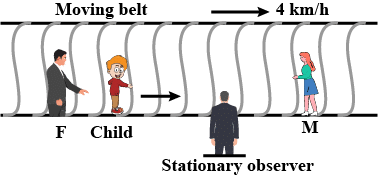
In this case,
Speed of belt w.r.t. ground
∴ vBG = 4kmh−1
Speed of child w.r.t. belt
∴ vCB = 9kmh−1
∴ For an observer on a stationary platform, speed of child running in the direction of motion of the belt is
vCG = vCB + vBG = 9kmh−1 + 4kmh−1
= 13kmh−1
On a two-lane road, car A is travelling with a speed of 36 km h-1. Two cars B and C approach car A in opposite directions with a speed of 54 km h-1 each. At a certain instant, when the distance AB is equal to AC, both being 1 km, B decides to overtake A before C does. The minimum required acceleration of car B to avoid an accident is- a)1 ms-2
- b)1.5 ms-2
- c)2 ms-2
- d)3 ms-2
Correct answer is option 'A'. Can you explain this answer?
On a two-lane road, car A is travelling with a speed of 36 km h-1. Two cars B and C approach car A in opposite directions with a speed of 54 km h-1 each. At a certain instant, when the distance AB is equal to AC, both being 1 km, B decides to overtake A before C does. The minimum required acceleration of car B to avoid an accident is
a)
1 ms-2
b)
1.5 ms-2
c)
2 ms-2
d)
3 ms-2
|
|
Ajay Yadav answered |
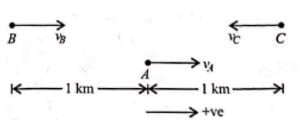
Velocity of car A ,

Velocity of car B ,

Velocity of car C ,
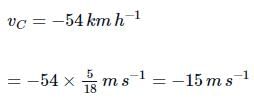
Relative velocity of car B w.r.t. car A
vBA = vB−vA = 15ms−1−10ms−1 = 5ms−1
Relative velocity of car C w.r.t. car A is
vCA = vC−vA = −15ms−1 − 10ms−1=−25ms−1
At a certain instant, both cars B and C are at the same distance from car A
i.e. AB − BC = 1km = 1000m
Time taken by car C to cover 1km to reach car A

In order to avoid an accident, the car B accelerates such that it overtakes car A in less than 40s. Let the minimum required acceleration be a. Then,



In order to avoid an accident, the car B accelerates such that it overtakes car A in less than 40s. Let the minimum required acceleration be a. Then,


If n is a unit vector in the direction of the vector  then
then
- a)

- b)

- c)

- d)

Correct answer is option 'A'. Can you explain this answer?
If n is a unit vector in the direction of the vector  then
then
 then
thena)

b)

c)

d)

|
|
Mira Joshi answered |
Unit vector is vector with magnitude unity but having specific direction.
Value of unit vector is given by:


Where,
 = unit vector
= unit vectorA = vector a
∣A∣ = magnitude of vector a
A vector is not changed if- a)It is displaced parallel to itself
- b)It is rotated through an arbitrary angle
- c)it is cross-multiplied by a unit vector
- d)It is multiplied by an arbitrary scalar
Correct answer is option 'A'. Can you explain this answer?
A vector is not changed if
a)
It is displaced parallel to itself
b)
It is rotated through an arbitrary angle
c)
it is cross-multiplied by a unit vector
d)
It is multiplied by an arbitrary scalar
|
|
Dev Patel answered |
When a vector is displaced parallel to itself, neither its magnitude nor its direction changes.
Two cars A and B are running at velocities of 60 km h−1 and 45 km h−1. What is the relative velocity of car A with respect to car B, if car A is moving eastward and car B is moving westward?
- a)15 km h-1
- b)45 km h-1
- c)60 km h-1
- d)105 km h-1
Correct answer is option 'D'. Can you explain this answer?
Two cars A and B are running at velocities of 60 km h−1 and 45 km h−1. What is the relative velocity of car A with respect to car B, if car A is moving eastward and car B is moving westward?
a)
15 km h-1
b)
45 km h-1
c)
60 km h-1
d)
105 km h-1
|
|
Raghav Bansal answered |
Velocity of car A w.r.t. ground
∴ vAG = 60 kmh−1 as it is moving towards east
Velocity of car B w.r.t. ground
∴vBG = -45 km h−1 as it is moving towards west
Relative velocity of car A w.r.t. B
vAB = vAG - vBG
= 60 - (-45) = 60 + 45= 105 km h−1
Two towns A and B are connected by a regular bus service with a bus leaving in either direction every T minutes. A man cycling with a speed of 20 kmh-1 in the direction A to B notices that a bus goes past him every 18 min in the direction of his motion, and every 6 min in the opposite direction. The period T of the bus service is- a)4.5 min
- b)9 min
- c)12 min
- d)24 min
Correct answer is option 'B'. Can you explain this answer?
Two towns A and B are connected by a regular bus service with a bus leaving in either direction every T minutes. A man cycling with a speed of 20 kmh-1 in the direction A to B notices that a bus goes past him every 18 min in the direction of his motion, and every 6 min in the opposite direction. The period T of the bus service is
a)
4.5 min
b)
9 min
c)
12 min
d)
24 min
|
|
Ananya Das answered |
Let vkmh−1 be the constant speed with which the bus travel ply between the towns A and B .
Relative velocity of the bus from A to B with respect to the cyclist = (v − 20)kmh−1
Relative velocity of the bus from B to A with respect to the cyclist = (v + 20)kmh−1
Distance travelled by the bus in time T (minutes) = vT
As per question

Equating (i) and (ii) , we get
= 18v − 18 x 20 = 6v + 20 × 6
or 12v = 20 x 6 + 18 x 20 = 480 or v = 40 kmh−1
Putting this value of v in (i) , we get
40T = 18 x 40 − 18 x 20 = 18 x 20

A jet airplane travelling at the speed of 500kmh−1 ejects its products of combustion at the speed of 1500kmh−1 relative to the jet plane. The speed of the products of combustion with respect to an observer on the ground is- a)500 km h-1
- b)1000 km h-1
- c)1500 km h-1
- d)2000 km h-1
Correct answer is option 'B'. Can you explain this answer?
A jet airplane travelling at the speed of 500kmh−1 ejects its products of combustion at the speed of 1500kmh−1 relative to the jet plane. The speed of the products of combustion with respect to an observer on the ground is
a)
500 km h-1
b)
1000 km h-1
c)
1500 km h-1
d)
2000 km h-1
|
|
Hansa Sharma answered |
Veloity of jet plane w.r.t ground vjG = 500 km h-1
Velocity of products of combustion w.r.t jet plane vCJ = -1500 kmh-1
∴ Velocity of products of combustion w.r.t ground is vCG = vCJ + vJG = - 1500kmh-1 + 500 kmh-1
= -1000 km h-1
-ve sign shows that the direction of products of combustion is opposite to that of the plane
∴ Speed of the products of combustion w.r.t ground = 1000 km h-1
Velocity of products of combustion w.r.t jet plane vCJ = -1500 kmh-1
∴ Velocity of products of combustion w.r.t ground is vCG = vCJ + vJG = - 1500kmh-1 + 500 kmh-1
= -1000 km h-1
-ve sign shows that the direction of products of combustion is opposite to that of the plane
∴ Speed of the products of combustion w.r.t ground = 1000 km h-1
The position vector of a particle is  .The velocity of the particle is
.The velocity of the particle is- a)Parallel to the position vector
- b)Perpendicular to the position vector
- c)Directed towards the origin
- d)Directed away from the origin
Correct answer is option 'B'. Can you explain this answer?
The position vector of a particle is  .The velocity of the particle is
.The velocity of the particle is
 .The velocity of the particle is
.The velocity of the particle isa)
Parallel to the position vector
b)
Perpendicular to the position vector
c)
Directed towards the origin
d)
Directed away from the origin

|
EduRev Class 9 answered |


As
 therefore velocity of the particle is perpendicular to the position vector.
therefore velocity of the particle is perpendicular to the position vector.A 175m long train is travelling along a straight track with a velocity 72km−1h. A bird is flying parallel to the train in the opposite direction with a velocity 18km−1h. The time taken by the bird to cross the train is- a)35 s
- b)27 s
- c)11.6 s
- d)7 s
Correct answer is option 'D'. Can you explain this answer?
A 175m long train is travelling along a straight track with a velocity 72km−1h. A bird is flying parallel to the train in the opposite direction with a velocity 18km−1h. The time taken by the bird to cross the train is
a)
35 s
b)
27 s
c)
11.6 s
d)
7 s

|
Infinity Academy answered |
The bird and train are moving in opposite directions, so their relative speed is the sum of their speeds: (72 km/h + 18 km/h) = 90 km/h.
Converting this speed into meters per second, we get 90 km/h = 25 m/s in SI units.
The train is 175 meters long. To find the time taken by the bird to cross the train, we use the formula: Time = Distance/Speed.
Thus, Time = 175 m / 25 m/s = 7 seconds.
If a vector  makes angles α, β and γ with X, Y and Z axes respectively then sin2α + sin2β + sin2γ is equal to
makes angles α, β and γ with X, Y and Z axes respectively then sin2α + sin2β + sin2γ is equal to - a)0
- b)1
- c)2
- d)3
Correct answer is option 'C'. Can you explain this answer?
If a vector  makes angles α, β and γ with X, Y and Z axes respectively then sin2α + sin2β + sin2γ is equal to
makes angles α, β and γ with X, Y and Z axes respectively then sin2α + sin2β + sin2γ is equal to
 makes angles α, β and γ with X, Y and Z axes respectively then sin2α + sin2β + sin2γ is equal to
makes angles α, β and γ with X, Y and Z axes respectively then sin2α + sin2β + sin2γ is equal to a)
0
b)
1
c)
2
d)
3
|
|
Suresh Iyer answered |
cos2 α + cos2 β + cos2 Y = 1
(1 - sin2 α) + (1 - sin2 β) + (1 - sin2 Y) = 1
or sin2 α + sin2 β + sin2 Y = 3 - 1 = 2
(1 - sin2 α) + (1 - sin2 β) + (1 - sin2 Y) = 1
or sin2 α + sin2 β + sin2 Y = 3 - 1 = 2
A ball A is thrown up vertically with a speed u and at the same instant another ball B is released from a height h. At time t, the speed of A relative to B is- a)u
- b)u - 2gt
- c)

- d)2u
Correct answer is option 'A'. Can you explain this answer?
A ball A is thrown up vertically with a speed u and at the same instant another ball B is released from a height h. At time t, the speed of A relative to B is
a)
u
b)
u - 2gt
c)

d)
2u
|
|
Ananya Das answered |
Taking upwards motion of ball A for time t, its velocity is VA = U - gt.
Taking downwards motion of ball B for time, its velocity is VB = gt.
Relative velocity of A w.r.t. B
=VAB = VA -(-VB) = (u - gt) - (-gt) = u
Taking downwards motion of ball B for time, its velocity is VB = gt.
Relative velocity of A w.r.t. B
=VAB = VA -(-VB) = (u - gt) - (-gt) = u
The components of Vector  along the directions of vectors (
along the directions of vectors ( ) is
) is- a)1/√2
- b)- 1/√2
- c)1/2
- d)-1/2
Correct answer is option 'B'. Can you explain this answer?
The components of Vector  along the directions of vectors (
along the directions of vectors ( ) is
) is
 along the directions of vectors (
along the directions of vectors ( ) is
) isa)
1/√2
b)
- 1/√2
c)
1/2
d)
-1/2
|
|
Suresh Iyer answered |
Given  , (say) components of
, (say) components of  along the direction of
along the direction of 

 , (say) components of
, (say) components of  along the direction of
along the direction of 

Chapter doubts & questions for Scalars and Vectors - Physics for JAMB 2025 is part of JAMB exam preparation. The chapters have been prepared according to the JAMB exam syllabus. The Chapter doubts & questions, notes, tests & MCQs are made for JAMB 2025 Exam. Find important definitions, questions, notes, meanings, examples, exercises, MCQs and online tests here.
Chapter doubts & questions of Scalars and Vectors - Physics for JAMB in English & Hindi are available as part of JAMB exam.
Download more important topics, notes, lectures and mock test series for JAMB Exam by signing up for free.
Physics for JAMB
259 videos|253 docs|230 tests
|

Contact Support
Our team is online on weekdays between 10 AM - 7 PM
Typical reply within 3 hours
|
Free Exam Preparation
at your Fingertips!
Access Free Study Material - Test Series, Structured Courses, Free Videos & Study Notes and Prepare for Your Exam With Ease

 Join the 10M+ students on EduRev
Join the 10M+ students on EduRev
|

|
Create your account for free
OR
Forgot Password
OR
Signup to see your scores
go up
within 7 days!
within 7 days!
Takes less than 10 seconds to signup





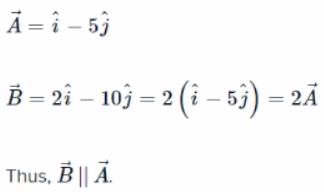
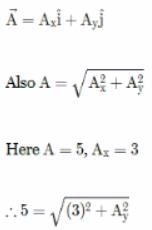
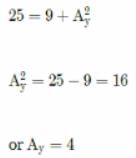
 , the angle between
, the angle between  and y-axis is
and y-axis is
 . The distance traversed in first 10 sec is
. The distance traversed in first 10 sec is
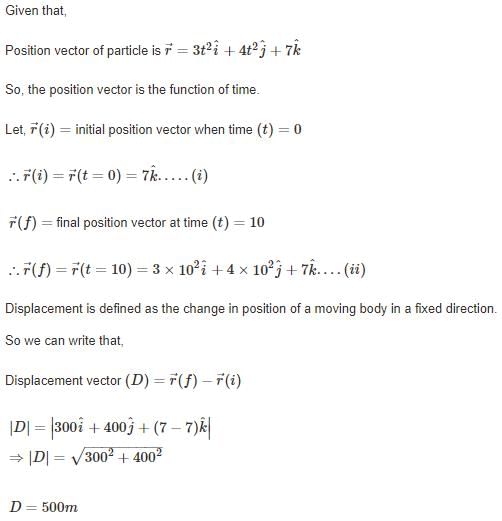
 is a
is a 
 will be
will be


 then which of the following is NOT correct
then which of the following is NOT correct





 Its length in XY plane is
Its length in XY plane is 










